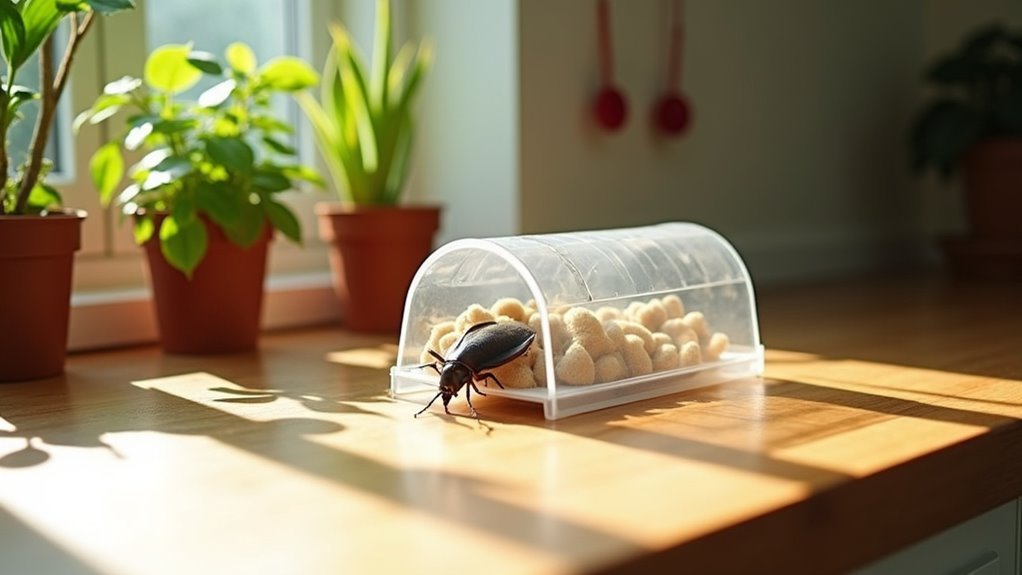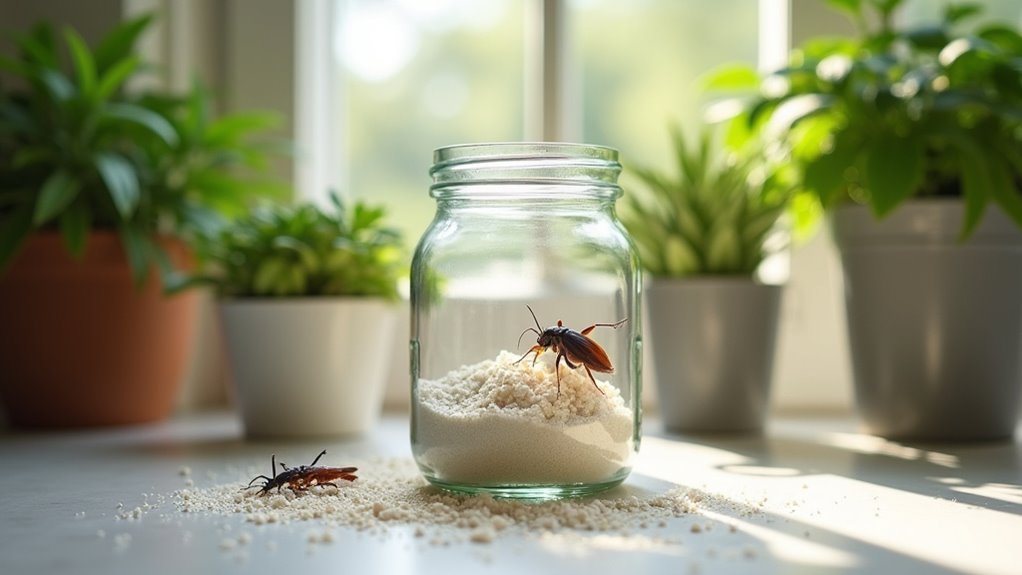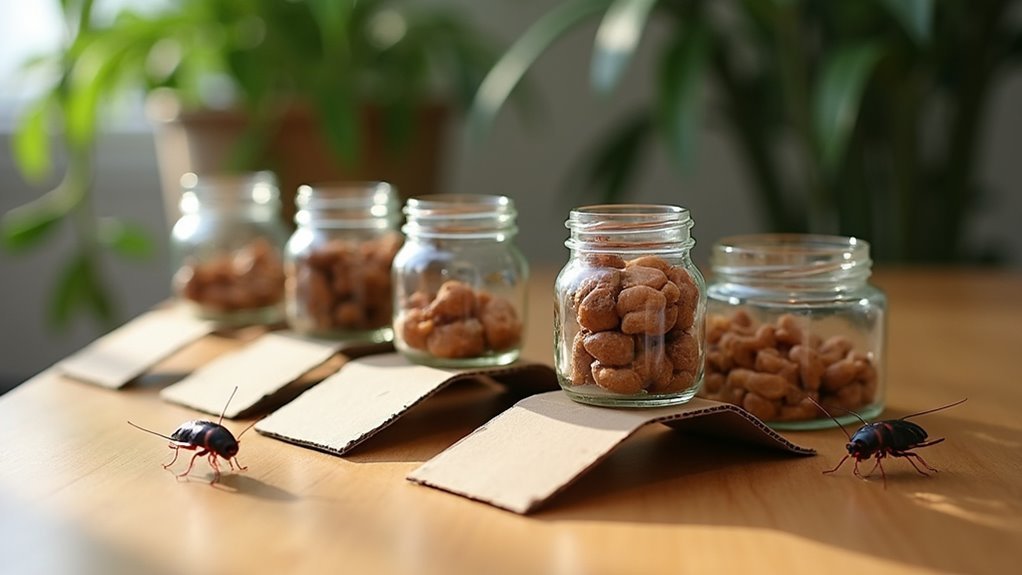You can make effective pet-friendly roach traps using sugar and baking soda mixed in equal parts, or create boric acid baits combined with honey that target roaches’ nervous systems while staying safe for pets. Food-grade diatomaceous earth also works by damaging cockroaches’ exoskeletons when applied to baseboards and cracks. Place these homemade solutions in areas your pets can’t reach, replace them every week, and monitor daily for best results. This thorough approach will help you master complete roach elimination strategies.
Understanding Why Cockroaches Are Dangerous for Pets

While cockroaches might seem like harmless household nuisances, they pose serious health risks to your beloved pets. When your dog or cat hunts down a roach, they’re potentially ingesting harmful bacteria and pathogens that can trigger severe gastrointestinal problems.
These pests carry dangerous microorganisms that aren’t safe for use around animals. Cockroach allergens create additional respiratory complications for pets, causing breathing difficulties and allergic reactions similar to those experienced by humans.
Your pet might also suffer from vomiting or toxic reactions after consuming contaminated insects or food. Even cockroach droppings contribute to health problems, causing skin irritations in sensitive animals.
The constant presence of these pests increases stress levels in pets, negatively affecting their behavior and overall well-being in your home environment.
Essential Ingredients for Safe Homemade Roach Traps
Creating effective roach traps doesn’t require harsh chemicals that could harm your pets. You can make powerful homemade traps using simple essential ingredients found in your kitchen.
Sugar and baking soda form the perfect combination – mix equal parts to attract roaches with the sweetness while the baking soda acts as a deadly agent when ingested. Place this mixture in shallow dishes where roaches frequent.
For enhanced effectiveness, add a few drops of dish soap to break surface tension and prevent escape.
You can also create a pet-friendly roach trap using vinegar and water sprayed on cardboard for a sticky surface. These non-toxic ingredients will kill roaches effectively while keeping your furry friends safe from harmful exposure.
Sugar and Baking Soda Trap Recipe

Since you already have sugar and baking soda in your pantry, you can make this lethal roach trap in under two minutes.
These pet safe roach traps work because sugar attracts roaches while baking soda becomes toxic when they ingest it.
Mix equal parts sugar and baking soda in a bowl or jar.
Pour this mixture into shallow pans and place them where you’ve spotted roaches frequently.
The dry powder consistency makes it easy for roaches to access.
Replace the mixture every 12-20 hours when it’s most potent.
While both ingredients are non-toxic to pets in small amounts, keep traps out of their reach.
For best results, combine these homemade roach traps with regular cleaning and sealing entry points.
Boric Acid Based Pet-Safe Baits
Although boric acid sounds intimidating, it creates one of the most effective pet-safe roach baits you can make at home. This pet safe roach killer targets cockroaches’ nervous systems while remaining relatively safe to use around your furry friends when applied properly.
Mix equal parts boric acid, sugar, and honey or Karo syrup to create an irresistible roach bait. The sweeteners attract cockroaches while the boric acid dehydrates them upon ingestion.
Sweet ingredients like sugar and honey mask the deadly boric acid, creating an effective bait cockroaches cannot resist.
Place this mixture behind appliances and in cracks where pets can’t reach but roaches frequent. Monitor and replenish your bait regularly for maximum effectiveness.
The boric acid works slowly, allowing infected roaches to return to their colonies and spread the poison to other members, creating a domino effect throughout the infestation.
Diatomaceous Earth Roach Control Method

You’ll find diatomaceous earth stands out as one of the safest roach control methods for pet owners, as this natural powder comes from fossilized algae and works by damaging cockroaches’ exoskeletons.
When you apply food-grade DE properly in dry areas like baseboards and cracks, it’ll gradually dehydrate roaches without posing significant risks to your furry companions.
Don’t expect instant results—this natural approach typically takes 1-3 weeks to show visible population reduction, but it’s worth the wait for chemical-free pest control.
What Is Diatomaceous Earth
Diatomaceous earth stands out as one of nature’s most effective yet gentle pest control solutions for households with pets. This fine powder comes from fossilized remains of tiny aquatic organisms called diatoms.
When cockroaches encounter DE, its microscopic sharp edges cut through their exoskeleton, causing fatal dehydration. This natural roach control method works slowly but effectively as insects lose moisture and die over time.
Food-grade diatomaceous earth is completely safe for pets when used properly, making it an ideal alternative to toxic chemical sprays. You’ll want to apply it strategically in high-traffic roach areas like baseboards, dark corners, and entry points.
While it doesn’t kill cockroaches instantly, this natural approach builds effectiveness as more pests contact the abrasive dust.
Safe Application Methods
When applying diatomaceous earth around your home, start by identifying the specific routes cockroaches use to navigate your living spaces.
Focus on high-traffic areas like cracks, crevices and places where roaches commonly travel, including dark corners and wall gaps.
Use safe application methods by dusting a thin layer of diatomaceous earth in these targeted zones, ensuring you’re applying it in dry conditions since moisture reduces its effectiveness.
Keep pets cant access areas where you’ve applied DE by choosing locations your animals don’t frequent.
While diatomaceous earth is non-toxic, prevent your pets from rolling in or inhaling the powder to avoid respiratory irritation.
Regularly monitor and reapply the powder after cleaning or if it becomes wet to maintain an effective barrier.
Expected Results Timeline
After properly applying diatomaceous earth using safe methods, patience becomes key to seeing results.
You’ll typically notice effectiveness within 1 to 3 weeks as DE gradually dehydrates roaches that contact it. Unlike bait stations or growth regulators that work differently, DE’s low toxicity means slower but steady progress through accumulating effects rather than immediate kills.
Expect multiple weeks before seeing significant population reduction. Reapply regularly, especially in moisture-prone areas where DE can clump or wash away.
Focus applications in high-traffic zones where you frequently see roaches to maximize contact opportunities.
Monitor progress while maintaining cleanliness to enhance DE’s effectiveness. This pet-safe method won’t keep roaches away instantly, but consistent application and proper maintenance will eventually reduce their numbers through gradual dehydration.
Strategic Placement of Homemade Traps
Since roaches prefer dark, secluded areas for foraging and hiding, you’ll want to position your homemade traps in locations where these pests naturally congregate.
Target the shadows where roaches thrive by placing traps in their preferred dark hideouts and feeding zones.
Strategic placement is essential for maximizing your trap’s effectiveness while keeping your pets safe.
Focus on these key areas when positioning your homemade traps:
- Behind appliances – Place traps behind refrigerators, stoves, and dishwashers where roaches frequently travel.
- Under sinks – Target bathroom and kitchen cabinets where moisture attracts these pests.
- Near food sources – Position traps close to pantries, pet food areas, and garbage cans.
- Dark areas – Utilize corners of cabinets, basement spaces, and closets where roaches hide.
Remember to place multiple traps throughout your home and keep them elevated or enclosed to prevent pet access.
Monitoring and Maintaining Your Roach Traps
You’ll need to check your pet-friendly roach traps every few days to assess their effectiveness and guarantee they’re still working properly.
Replace traps when they become full of roaches or lose their stickiness, as overcrowded or ineffective traps won’t capture new pests.
Keep a simple log of which traps catch the most roaches to identify high-activity areas and adjust your placement strategy accordingly.
Check Traps Daily
Daily inspection of your pet-friendly roach traps forms the cornerstone of effective pest management.
When you check traps daily, you’ll monitor their effectiveness and make necessary adjustments to your baiting strategy.
Here’s your daily trap inspection routine:
- Count and document the number of roaches caught to track your pest control success over time.
- Remove trapped roaches immediately to prevent odors and maintain trap functionality.
- Assess bait condition and replace it if it’s dried out or contaminated.
- Evaluate trap placements and reposition them if certain areas aren’t producing results.
If you’re not catching roaches after several days, experiment with different bait options or move traps to new locations where you’ve spotted recent roach activity.
Replace When Full
When your pet-friendly roach traps reach capacity, prompt replacement becomes essential for maintaining effective pest control. Replace when full or after one week, whichever comes first, to prevent roaches from escaping and maintain peak trap performance.
| Trap Status | Action Required | Timeline |
|---|---|---|
| Partially Full | Monitor for activity | Every 2-3 days |
| Nearly Full | Prepare replacement | Within 24 hours |
| Full/Weekly Limit | Replace immediately | Same day |
Always wear gloves when disposing of used roach traps to maintain proper hygiene. Count the captured roaches in each trap to assess the severity of your infestation. This data helps you adjust placement strategies and determine if additional pest control measures are necessary for your home.
Record Activity Patterns
Although roach activity might seem random, establishing a systematic recording process reveals valuable patterns that transform your pest control strategy from guesswork into precision targeting.
When you monitor the traps regularly, you’ll discover roaches follow predictable routines based on temperature, humidity, and food availability. Document these findings to maximize your efforts:
- Check traps every 2-3 days and record the exact number of roaches caught in each location.
- Note the time of day when you find the most activity to understand their movement schedules.
- Track which bait types in different traps attract more roaches for future reference.
- Map high-traffic areas by comparing catch numbers across all trap locations.
This systematic approach helps you record activity patterns effectively, enabling you to concentrate your pest control efforts where roach activity peaks most consistently.
When to Upgrade to Professional Pet-Safe Solutions
If your DIY pet-safe traps haven’t greatly reduced the roach population after a few weeks of consistent use, it’s time to contemplate professional pest control solutions. When you upgrade to professional services, you’ll get targeted methods designed for effective management while keeping your pets safe.
| DIY Approach | Professional Solution | Pet Safety Level |
|---|---|---|
| Limited effectiveness | Extensive treatment | High with customization |
| Single method focus | Integrated pest management | Veterinarian-approved options |
| Slow results | Faster population control | Tailored to pet types |
| Basic monitoring | Advanced tracking systems | Regular safety assessments |
| Trial and error | Proven methodologies | Professional risk evaluation |
Professional exterminators customize treatments based on your pet’s presence, ensuring animal health isn’t compromised while delivering superior roach control through integrated strategies.
Frequently Asked Questions
How Do I Get Rid of Roaches Without Harming My Pet?
You can eliminate roaches safely by using sticky traps, homemade boric acid bait in pet-inaccessible areas, food-grade diatomaceous earth, regular HEPA vacuuming, and maintaining cleanliness while sealing food sources.
What Is the Best Homemade Roach Trap?
Mix equal parts sugar and baking soda in a jar, coating the rim with oil to trap roaches inside. Place it where you’ve seen roach activity and replace regularly for best results.
What Is the Best Homemade Roach Killer?
You’ll find baking soda mixed with sugar works best as a homemade roach killer. The sugar attracts roaches while baking soda’s toxicity eliminates them effectively when ingested.
How to Make Homemade Cockroach Bait?
You’ll combine equal parts sugar and baking soda to create an effective cockroach bait. Place this mixture in shallow dishes near roach activity areas, keeping it away from pets for safety.
In Summary
You’ve learned multiple pet-safe methods to tackle your roach problem without endangering your furry friends. Start with the simplest traps using ingredients you already have, then progress to more targeted solutions if needed. Remember to place traps strategically where pets can’t reach them, and don’t hesitate to call professionals if the infestation persists. Your pets’ safety should always come first while effectively eliminating these unwanted pests.





Leave a Reply